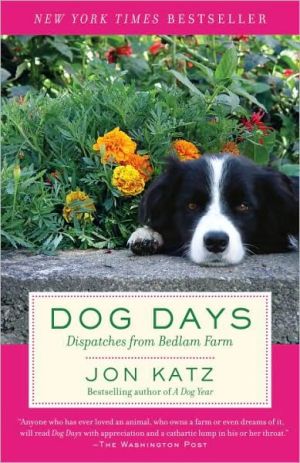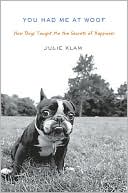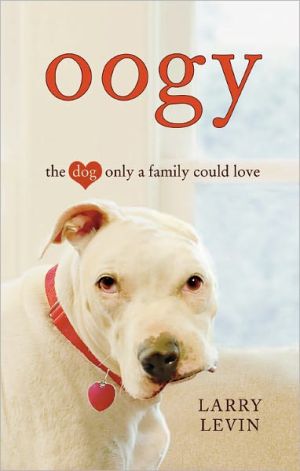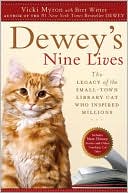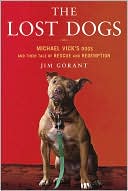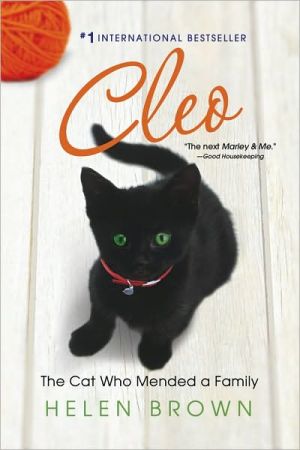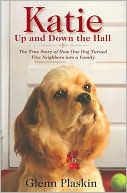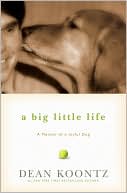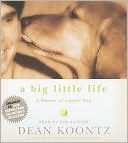Dog Days: Dispatches from Bedlam Farm
In Dog Days, Jon Katz, the squire of Bedlam Farm, allows us to live our dreams of leaving the city for the country, and shares the unpredictable adventure of farm life. The border collies, the sheep, the chickens, the cat, the ram, and one surprisingly sociable steer named Elvis all contribute to the hum (and occasional roar) of Bedlam. On timeless summer days and in punishing winter storms, Katz continues his meditation on what animals can selflessly teach us–and what we in turn owe to them....
Search in google:
In Dog Days, Jon Katz, the squire of Bedlam Farm, allows us to live our dreams of leaving the city for the country, and shares the unpredictable adventure of farm life. The border collies, the sheep, the chickens, the cat, the ram, and one surprisingly sociable steer named Elvis all contribute to the hum (and occasional roar) of Bedlam. On timeless summer days and in punishing winter storms, Katz continues his meditation on what animals can selflessly teach us–and what we in turn owe to them. With good neighbors, a beautiful landscape, and tales of true love thrown in, Dog Days gives us not only marvelous animal stories but a rich portrait of the harmonious world that is Bedlam Farm.Praise for Dog Days:“Anyone who has ever loved an animal, who owns a farm or even dreams of it, will read Dog Days with appreciation and a cathartic lump in his or her throat.” –The Washington Post“Katz proves himself a Thoreau for modern times as he ponders the relationships between man and animals, humanity and nature, and the particularly smelly qualities of manure.”–Fort Worth Star-Telegram“Katz constructs the perfect blend between self-revelation and his subtle brand of humor.”–The Star-Ledger“City-dweller-turned-farmer Katz . . . returns with further adventures from his animal-filled upstate New York sheep farm. Charming.”–People “The perfect summer book . . . You will not be disappointed.”–The Philadelphia Inquirer“A new twist on the American dream.”–The Christian Science Monitor“Thoroughly enchanting.”–The Dallas Morning News The New York Times - David Updike Though not a religious man, [Katz] reads St. Augustine to the dogs on Easter morning, and is on a quest for a kind of wholeness he no longer felt back in his former life. In late middle age, he has had the conviction to do what many of us have imagined but will never do: sell the suburban cash cows we live in, and buy some real ones, way up north.
Chapter 1\ ONE\ Carol’s Time\ About that baby donkey. As I was heading down Route 30 a couple of weeks earlier, returning from the hardware store in town, my cell phone warbled. Anthony, working at the farm that day, was calling to say that there was a new donkey in the pasture.\ Knowing this had to be a joke, since I had no male donkeys and, to my knowledge, no pregnant ones either, I laughed, fired off some appropriately obscene macho banter—the staple of male conversation hereabouts—and hung up.\ It never really crossed my mind that it was true.\ When I pulled into the driveway, though, I nearly drove into a fencepost. There was a tiny new donkey, soaking wet from amniotic fluid, hugging close to Jeannette, my most recently acquired Sicilian donkey. The afterbirth was close by and fresh. And Jeannette was snorting like a bull and glowering at any interlopers.\ No way, I thought.\ Way. Obviously, donkeys have a very long gestation period. Jeannette must have got knocked up just before she arrived last spring. I phoned an SOS to the Granville Large Animal Veterinary Service and ran into the house for some towels.\ Jeannette and I are pretty tight, thanks to my daily offerings of carrots, apples, and oat cookies. She let me pick up her newborn—I named her Emma, after my own daughter—dry her off, and make sure her throat and eyes were clear. When I scratched her fuzzy little nose, she closed her eyes and went to sleep in my arms.\ I gave Jeannette some cookies for energy, checked to see that she had milk in her teats—she did, a lot of it—and brushed her down a bit to calm her. Then I knelt in front of her and she put her head on my shoulder.\ “Congratulations,” I said. “Who’s the father? You can tell me.” But she just went over to Emma and nosed her.\ There aren’t many donkeys born around here these days. Once, donkeys were the tractors and ATVs of country life, performing agricultural and mercantile tasks integral to farming and commerce. Now they’re generally considered useless—local farmers call them “hay suckers”—so they’re rare. So people from nearby farms soon began showing up to check out the newcomer, alerted by the mysterious rural news network by which everyone instantly knows everything.\ In an hour or so, Kirk the vet showed up, gave the donkeys their appropriate shots, said they were fine. He also told me that Emma was, oops, a male. So “she” became Jesus (using the Spanish pronunciation), thanks to the mysterious circumstances of his birth.\ I razzed Kirk about the fact that two large-animal vets had been by in recent weeks and, when I mentioned Jeannette’s burgeoning girth, said she’d been eating too much hay and probably had gas.\ Truth to tell, I felt guilty about the way I’d been mocking Jeannette for her hearty appetite and swelling belly, never guessing that she was eating for two. Probably she should have had better prenatal care, possibly some supplements. But she’d managed the whole process quite efficiently on her own, it seemed, even selecting an unusually warm February day to give birth.\ A cold wave was approaching in forty-eight hours, though, so we scurried to find the heat lamps and bring Jeannette and Jesus into a cozy corner of the barn.\ All this made me think even more about why I own donkeys at all.\ When I got my troubled border collie Orson, we started learning to herd at a sheep farm in Pennsylvania. A lonely old donkey named Carol lived in the adjacent pasture. We bonded; I was enchanted by her soulful eyes and gentle bray, and she loved the apples I brought her and the pats and scratches that accompanied them. When I bought the farm in upstate New York, I imported some of the sheep we’d been herding with. They arrived on a livestock trailer, and Carol showed up with them, a surprise gift from the farmer, who thought she deserved a better life.\ Carol seemed initially stunned, then appreciative of her new life— ample pasture, fresh water, treats and cookies, pats and grooming. But she had some serious health issues. That meant a lot of visits from vets, something Carol didn’t appreciate—Amanda, her primary care physician, had to call a half hour before coming, so I could lure Carol into the barn with oats. Carol could hear Amanda’s truck from some distance, and if she could, she’d take off up the hill.\ She needed the vets, though. She’d arrived with all sorts of ailments— eye infections, bad circulation, and weak lungs. Our first winter, she’d foundered (foundering is an equine wasting disease of the hoof), and developed sores and abscesses. I’d spent innumerable hours, often in the middle of the night and in freezing temperatures, administering shots, pills, and salves. The veterinary bills, plus the shelves of painkillers, antibiotics, syringes, and thermometers, had run into the thousands.\ I think I’d never truly lived until I was called upon to take a rectal thermometer reading from an agitated donkey at five a.m. when the temperature was twenty below.\ Carol was agreeable, but not that agreeable. We had many a brawl in the barn and pasture while I attempted to administer her growing list of meds. She wasn’t above running, butting, bumping, or dragging me if she spotted a hypodermic.\ The nasty case of frostbite that plagues me to this day came one bitter night as she dragged me up the hill to avoid the thermometer.\ Paula asked why I hadn’t dressed more warmly, but my neighbors just shrug. They understand the logistics of rectal thermometers: It doesn’t work with gloves. Generally Carol submitted, not always graciously.\ It seems absurd but, over time, I swear she could read my intentions, or perhaps my emotions. If I was simply bringing oats for a treat, Carol came running. If I had an agenda, like an approaching vet’s or farrier’s appointment, she’d trot out of reach. Carol hadn’t survived all her years by being foolish.\ But she had a calming quality I found eerily soothing. Every night before bed, Rose and I went out to the barn. I carried a granola bar for myself and a cup of oats for Carol. Rose—always eager to work but able to grasp the import of certain moments—lay down and hardly moved.\ I sat on an old stool while Carol and I—and later Fanny—had our nightly munch-and-crunch. I’d put some music on a boom box I left out there. Carol liked Willie Nelson the most; he seemed to ease her mind.\ “You really ought to shoot her,” my neighbor, a retired dairy farmer, repeatedly advised. “You’ll never get your money back from her.” That was surely true. He even offered several times to get his deer rifle and do the deed for me.\ Yet I was crazy about Carol, felt lucky to have her, and was determined to give her a more comfortable winter.\ About Carol’s compadres:\ Donkey Number 2 joined her when I got a phone call from a woman who described herself as a “Jewish donkey spiritualist,” a term I hadn’t heard before and don’t expect to hear again. Pat bred donkeys and had studied and written about their symbolic significance, their place in the ancient world, and their profoundly spiritual natures.\ Both Jewish and Christian theologies abound with biblical and other references to donkeys, she pointed out. Carol, like all my donkeys, wore a cross on her back, a pattern of dark hair behind the shoulders.\ Since donkeys are social sorts, Pat declared, Carol was not only lonely, but was unaware of her “donkeyness.” Having lived with sheep all of her life, she probably didn’t even know she was a donkey. She needed a companion, Pat said. My wife, already embittered by the vet bills, said she could live with Carol being out of touch with her donkeyness. I couldn’t, and so little Fanny soon arrived, and then Lulu, her half sister, who was Donkey Number 3.\ The Jewish donkey spiritualist was, of course, right about donkeys: They are sweet, accepting, seemingly wise. Mine have an ostensible purpose: They’re my security detail, fiercely protective of my flock of sheep. They run off stray dogs and coyotes. And as I’ve lost no sheep to these common predators, the donkeys seem to me to be doing their jobs pretty well.\ But they also—and this is why I have more donkeys than I truly need— attach to people. They nuzzle and lean into humans they like, which can sometimes be disconcerting but is also touching. They are gentle with children, calm around strangers. They coexist reasonably amiably with my dogs and chickens, getting irritated only when the hay feeder gets too crowded.\ When I sit out in the pasture, Lulu is usually the first to drift up behind me and rest her chin on the top of my head, waiting for her nose to be scratched. The others soon slide alongside, waiting for pats, carrots, scratches. We sit in this odd, cuddly huddle for long periods sometimes, especially when I need soothing or company. Their silent affection is quite potent, if you wait for it.\ Donkeys are always watching and miss little. Nothing seems to surprise them, or seems new to them. My private theory is that some of the wisdom of the ages has been passed along in their genes, and a little may rub off on me, if I allow it.\ When I come out of the house in the morning, the girls (and now Jesus, too) are waiting for me at the barnyard gate, wheezily braying for their cookies. Serious about snacks, they’re apt to nose into your pockets if you’re slow to produce them.\ But our connection goes well beyond food. Apart from the cuddling and brushing, I often go check on them at night before I go to sleep. During winter storms, I trudge up to the pole barn and comb ice from their long eyelashes; they hold still for the procedure, then nuzzle me in appreciation.\ Last year, donkey spiritualist Pat sold her farm. Before she moved away, she sold me Jeannette, one of her oldest donkeys (they live to be thirty, even forty). Nobody said anything about anybody being pregnant. But Jeannette was, apparently.\ So now there were four. “That’s a lot of hay,” one of my incredulous farmer neighbors observed. “Especially for animals that don’t do anything.”\ He’s wrong; they do a lot for me. They connect me to nature and history. They’re dutiful watchdonkeys, affectionate companions. In many ways, they are the soul of my farm. I want to do well by them.\ One of the many second-year innovations at the farm, therefore, was the Donkey Motel, a corner of the barn where Anthony had installed insulation, wiring for heat lamps, and a small hay feeder. The younger donkeys were hearty creatures, but Carol had suffered grievously from the cold the first winter; she’d need more protection.\ After all those lonely years by herself in the woods, she seemed entitled to a few easy ones on my farm. Anthony carefully sealed the cracks in the barn so the Donkey Motel would be sound.\ He appreciated her, even if he doubted my sanity for spending money on her. Anthony’s daughter, Ida, who was then two, liked to crawl beneath Carol’s legs, which didn’t bother Carol at all; she merely nuzzled Ida with her nose. Once, I was horrified to look up and see Ida and Carol munching on opposite ends of the same carrot. Anthony often said there was no safer place for his daughter than underneath that donkey.\ So that fall, when the farmer’s weather alert service—I loved merely being on the list—called to advise that winter was arriving suddenly and brutally, I felt prepared.\ Temperatures would drop from the forties into the single digits overnight, and high winds would drive the windchill well below zero, the service advised. “Winter is coming,” somebody said at the Bedlam’s Corner Variety Store down the hill, “with a bite.” But Carol would be safe in her motel.\ When I lived in Boston or Philadelphia or New Jersey, I couldn’t understand the big deal local newscasters made of weather forecasts. I looked out the window in the morning and either wore a raincoat or parka, or didn’t.\ But at Bedlam Farm, I pay acute attention. Weather isn’t just about what to wear, although that matters, but about livestock: hay supplies, feed and corn, deicers and water flow, shelter from the wind and wet. Most farm animals can handle all but the most brutal cold, but not my aging donkey.\ It had been evident all that summer that Carol was no longer hardy. She moved less, hugged the barn more, and as the fall chill came, she seemed weary, reserving her energy for the advancing winter.\ When it comes to animals, it’s easy to anthropomorphize, attributing human emotions and thoughts to other species. I’m certain that Carol had little sense of herself as tired or vulnerable, just as she probably had no concept of herself as “lonely.” She’d survived for many years on her own, without the hay and snacks I kept bringing. I would have been lonely and uncomfortable in her previous existence, but for all I know, she was content with her hideaway.\ To my mind, Carol had anchored that first chaotic, overwhelming year at Bedlam Farm, for which I was immensely grateful. She projected confidence and calm; she was so unflappable that she steadied me. She just made me feel better.\ And not only me. Kids from miles around came to see her and bring her carrots, and she greeted them all warmly and patiently, even when they shrieked or pulled cookies right out of her mouth.\ She appeared out of the mist or snow whenever I emerged from the house. She hovered over the birth of each lamb. I thought of her as the silent but faithful witness to this strange journey I’d taken with my dogs and my restless self.\ When I grew confused, frightened, or overburdened—which was a substantial part of the time—I could count on\ her affection. The one thing, apparently the only thing, she\ couldn’t handle was the cold. This year I thought I could spare her its worst effects.\ I wasn’t the only one concerned about her. In October, Ken Norman, the farrier from Pawlet, Vermont, came to trim the donkeys’ hooves. He drove a converted red fire truck stocked with medieval-looking tools. In his leather apron, he handled the donkeys with a particular ease and authority. Even Carol submitted calmly to his trimming and filing. As he worked, he talked quietly to “the girls.”\ He didn’t like the way Carol looked. “She’s wearing out,” he told me. As skilled as the large-animal vets were, I’d learned, nobody could read a donkey better than a farrier like Ken. It was still golden fall then, fairly warm, but I feared he was right. It had happened gradually, with nothing you could really put your finger on. Carol just seemed to do less of everything—explore, eat, leave the barn. Despite my preparations, I began to wonder.\ I e-mailed Pat, the spiritualist, saying I was worried about Carol and pondering how much more medical treatment to subject her to, should further problems arise.
\ From Barnes & NobleJon Katz shares his aptly named Bedlam Farm with his wife, four dogs, two cows, four donkeys, three hens, a rooster, a barn cat, and an indeterminate number of sheep. Living amid such an unruly menagerie, this inveterate pet lover can hardly regard himself as lord of the manor. Indeed, he must strive hard simply to rise above the chaos of his personal animal kingdom. As in A Good Dog and his other books, Katz balances entertaining anecdotes with insights about the creatures who share our lives.\ \ \ \ \ David UpdikeThough not a religious man, [Katz] reads St. Augustine to the dogs on Easter morning, and is on a quest for a kind of wholeness he no longer felt back in his former life. In late middle age, he has had the conviction to do what many of us have imagined but will never do: sell the suburban cash cows we live in, and buy some real ones, way up north.\ — The New York Times\ \ \ Publishers WeeklyNot only has Katz written 16 books, he cohosts Dog Talk on public radio, freelances for a variety of newspapers and magazines, and operates the eponymous Bedlam Farm in upstate New York—sometimes with his wife, but always with dogs and chickens and sheep and even a few donkeys and cows. Readers familiar only with Katz's suburban mystery novels will find that his farm memoirs set out to do basically the same thing, bring order to chaos. His goal in running Bedlam Farm is to find ways for his various animals and their humans to work together in harmonious synchronicity. Everything requires balance. He must be mindful of his own tendency to anthropomorphize, while remaining open to the emotional bonds his animals invite. He must remember that many awful things—flies, freezing weather, disease—are normal in the lives of animals, even as he struggles to give his animals the best life possible. He has to balance his focus on the farm with his relationship with his wife, who never particularly approved of the farm idea, even if she supported his need to do it. Anyone who loves animals or country life, but maybe can't have a pet or actually live in the country, will find Katz a perfect armchair companion. (June)\ Copyright 2007 Reed Business Information\ \ \ \ \ Library JournalKatz adds to the five big books he's already written about dogs and the rural life. Copyright 2007 Reed Business Information.\ \ \ \ \ Kirkus ReviewsA fourth installment from journalist Katz (A Good Dog, 2006, etc.) about his life and canine loves in upstate New York. After three years in residence at Bedlam Farm, the author finally has his bona fides as a farmer: "a sunburned complexion, the hunched crab-walk...frostbitten fingers." He already has a crew of hardworking dogs-border collie Rose, lovable Lab Clementine and injured Lab Pearl-when a new one enters his life. Izzy, a three-year-old border collie, has been rescued from a farm deserted by its ailing owner; the caretaker had fed him but otherwise left him to his own resources. Though wild and untrained, Izzy unexpectedly shows great sheep-herding potential, and Katz begins to spend more and more time honing his skills. Four dogs come to seem an unmanageable number. Rose is busy with her tasks on the farm, and Pearl works, unofficially, with the author at the physical therapy appointments for his bad back. But Clementine is frequently sidelined, and Katz reluctantly considers a startling solution: sharing ownership of Clem with Ali, a physical therapist who spends her off-hours hiking and playing soccer. It's a wrenching decision, but Clem blossoms as an "only dog" under Ali's care. Despite the book's title, there's more here than dog stories. Bedlam Farm hosts a herd of donkeys with which Katz shares a nightly snack and some music (the donkeys like Willie Nelson best), as well as an irrepressible, 1,800-pound steer named Elvis, who obeys simple commands when encouraged with apples. Katz's views of animals continue to evolve. He's come a long way from suburban pet ownership and now must consider not only the welfare of the animals, but also the welfare of the farm. An appealingtext showing off an author who's found his perfect genre. Readers can only hope these appealing and thoughtful dispatches will continue.\ \
